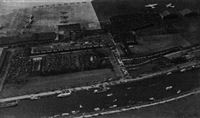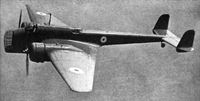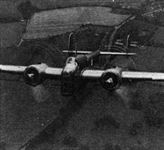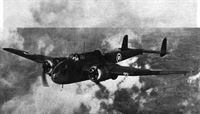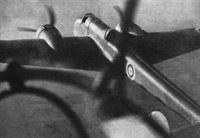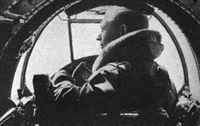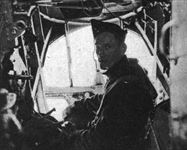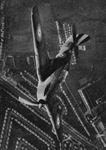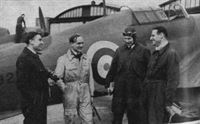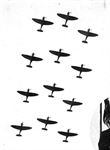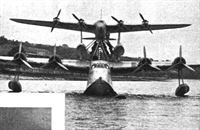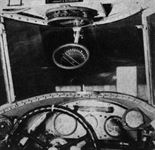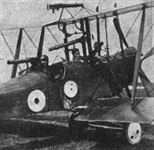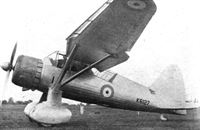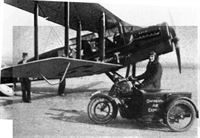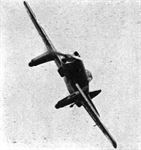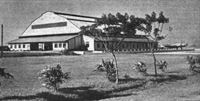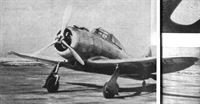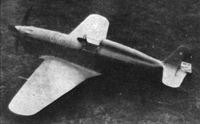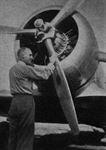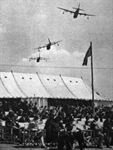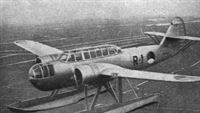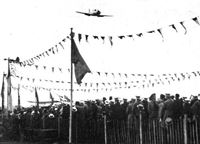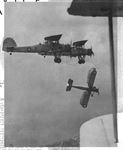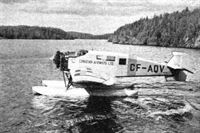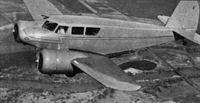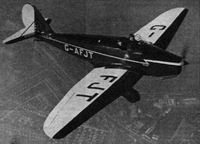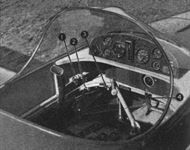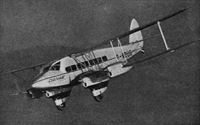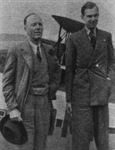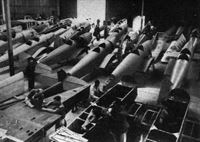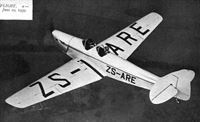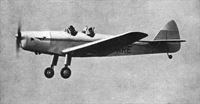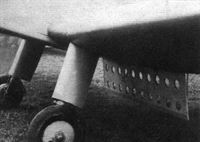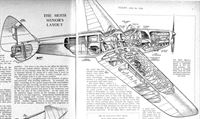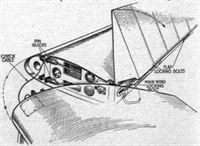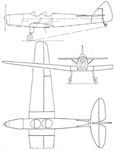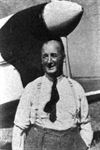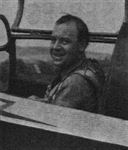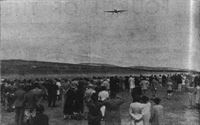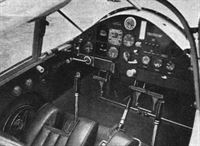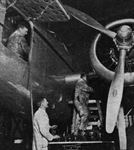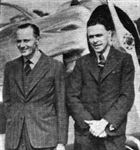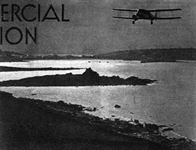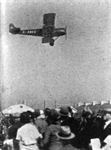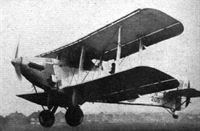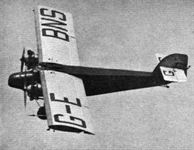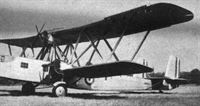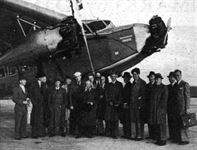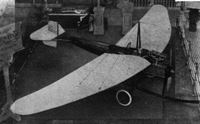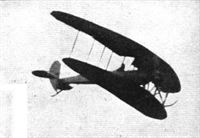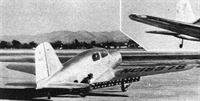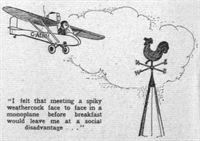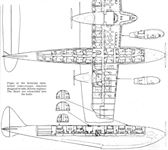Фотографии
-
A Bf 109B-2 at Augsburg-Haunstetten prior to acceptance by the Luftwaffe during the summer of 1937
German appreciation: The Messerschmitt Me.109 fighter is fitted with Handley Page slots and flaps.Самолёты на фотографии: Messerschmitt Bf.109 / Bf.109B / Bf.109C / Bf.109D - Германия - 1935
-
SUMMER AT SCHIPHOL: This aerial view of Amsterdam's airport gives an idea of the tremendous number of people who are encouraged to come out during the weekend and on fine evenings in the summer. On the tarmac axe half a dozen assorted Douglas while on the right are F.22’s and F-36’s, which are now used for joy riding. The Schiphol runway extensions to the north are now complete.
Самолёты на фотографии: Douglas DC-3 / C-47 Skytrain/С-53 Skytrooper / Dakota - США - 1935Fokker F.XXXVI / F.XXII - Нидерланды - 1934
-
Регистрационный номер: K4240 [4] Прототип H.P.52 (K4240) был полностью окрашен глянцевой краской серо-зеленого цвета. Впервые самолет публично продемонстрировали в июле 1936 года на авиашоу британских ВВС в Хендоне.
K4240 photographed in the late summer of 1936; it was painted glossy grey-green all over. In the H.P.52 or Hampden slots and flaps have taken the place of the early plan form, and the power has gone up to about 1,500 h.p.Самолёты на фотографии: Handley Page Hampden / H.P.52 - Великобритания - 1936
-
Регистрационный номер: K4240 [4] The Flight photograph referred to in the Editorial footnote to "Commonwealth’s" letter. The vortices visible at the airscrew tips have been very slightly touched-up for reproduction purposes, but they are just as clearly visible in the untouched original, and the picture is in no way "faked."
Самолёты на фотографии: Handley Page Hampden / H.P.52 - Великобритания - 1936
-
Регистрационный номер: K4240 [4] Самолёты на фотографии: Handley Page Hampden / H.P.52 - Великобритания - 1936
-
Бомбардировщик "Хэмпден" I в полете
Development: The production version of the Hampden, a bomber of outstanding merit.Самолёты на фотографии: Handley Page Hampden / H.P.52 - Великобритания - 1936
-
Регистрационный номер: K4240 [4] CLOSE-UP: Handley Page Hampden in rather startling proximity to another from which our photograph was taken.
Самолёты на фотографии: Handley Page Hampden / H.P.52 - Великобритания - 1936
-
INDOOR PHOTOGRAPHY: Some interesting close-ups secured recently by a Flight photographer: Hampden pilot
Самолёты на фотографии: Handley Page Hampden / H.P.52 - Великобритания - 1936
-
INDOOR PHOTOGRAPHY: Some interesting close-ups secured recently by a Flight photographer: Hampden wireless operator (photo was taken in the air)
Самолёты на фотографии: Handley Page Hampden / H.P.52 - Великобритания - 1936
-
HURRICANE OVER THE HOUSETOPS: A striking aerobatics photograph that recalls, in a curious way, a Spitfire picture which appeared in “Flight” a year ago, and which is reproduced again for comparison. Sqn. Ldr. J. W. Donaldson was the Hurricane pilot. The rudder stripes are shadows.
Самолёты на фотографии: Hawker Hurricane - Великобритания - 1935
-
JACK-IN-THE-BOX: A Hawker Hurricane, one of a batch built some time ago for Yugo-Slavia, test-piloted by Flt. Lt. R. C. Reynell, makes a startling entry through the cloud-floor.
Самолёты на фотографии: Hawker Hurricane - Великобритания - 1935
-
TALKING IT OVER: Hawker test pilots at Brooklands - Flt. Lt. Philip Lucas, Mr. K. G. Seth-Smith, Mr. John Grierson and Flt. Lt. R. C. Reynell.
Самолёты на фотографии: Hawker Hurricane - Великобритания - 1935
-
Регистрационный номер: OY-DAL Kastrup Airport, outside Copenhagen. The new buildings have just been opened. A British Airways Electra is on the right.
Самолёты на фотографии: Junkers Ju.52/3m - Германия - 1931Lockheed Electra 10 - США - 1934
-
FIGHTER CONTRAST: A Bristol Fighter (circa 1917) and a Vickers-Supermarine Spitfire seen at Netheravon on Empire Air Day.
Самолёты на фотографии: Bristol F.2A/F.2B Fighter - Великобритания - 1916Supermarine Spitfire - Великобритания - 1936
-
Perfection in formation - one of the magnificent figures by the twelve Spitfires which opened the R.A.F. section of the programme.
Самолёты на фотографии: Supermarine Spitfire - Великобритания - 1936
-
Регистрационный номер: G-ADHJ [2], G-ADHK The Mayo composite, a useful experiment in long-range assisted take-off development.
Самолёты на фотографии: Short Mayo Composite (S.20 Mercury and S.21 Maia) - Великобритания - 1938
-
Регистрационный номер: G-ADHJ [2] The roof-mounted P.4 compass in the Short-Mayo Mercury. For taking-off or landing the mirror shuts up flat against the compass-face and does not obstruct the pilot’s view.
Самолёты на фотографии: Short Mayo Composite (S.20 Mercury and S.21 Maia) - Великобритания - 1938
-
FLYING FORTRESS, CIRCA, 1916: Three “field service” Lewis guns formed the armament of this war-time BE.2C of No. 4 Squadron. The barrel casings with their internal finning were retained, no doubt, because the machine could not attain a sufficiently high speed to cool the naked barrels. Other points to note are the external aerial drum and the camera held by the pilot.
Самолёты на фотографии: RAF B.E.2c/B.E.2d - Великобритания - 1914
-
The Vickers Vimy taking-off from Newfoundland on the attempt. The engines were two Rolls-Royce Eagles of 375 h.p.
Самолёты на фотографии: Vickers Vimy / FB.27 - Великобритания - 1917
-
Регистрационный номер: K6127 The application of slots and slotted flaps has been brought to a high degree of perfection in the Westland Lysander. The leading-edge slots are linked to the slotted flaps and operate them automatically.
Самолёты на фотографии: Westland Lysander - Великобритания - 1936
-
Known as the O/400, the large bomber laid the real foundation of the greatness of the house of Handley Page.
The first British twin-engined bomber, the Handley Page O/400, had two Rolls-Royce "Eagle" engines of 360 h.p. each. This type did not come into service until near the end of the war. This type was to have been used for bombing Berlin, but the Armistice intervened.Самолёты на фотографии: Handley Page H.P.12 (O/400) - Великобритания - 1917
-
7 июля 1919г.: открыт первый аэропорт Лондона Хоунслоу Хит. Началась эра международных полетов.
Messrs. S. Instone and Co., Ltd., and their new London-Paris service from Hounslow Aerodrome: The "mail" arrives per sidecar;
The two-passenger Airco D.H.4 used by Air Transport and Travel for the first commercial services to Paris from Hounslow Heath - with freight delivery sidecar in the foreground. D.H.16s were also used.Самолёты на фотографии: De Havilland D.H.16 - Великобритания - 1919
-
Stages in the evolution of commercial aircraft. The W.8B;
Самолёты на фотографии: Handley Page H.P.18 (W.8) / H.P.30 (W.10) - Великобритания - 1919
-
Регистрационный номер: G-EBBG, G-EBBH THE HANDLEY PAGE W.8B: This machine was a 14-passenger, twin-engined (Rolls-Royce "Eagle") biplane, originally in service with Handley Page Transport, in 1922.
Typical machines at Waddon, alias Croydon, in 1922. Two Handley Page Transport W.8Bs - a picture taken when this type, a development of the O/400 bomber and the W.8., first went into serviceСамолёты на фотографии: Handley Page H.P.18 (W.8) / H.P.30 (W.10) - Великобритания - 1919
-
Регистрационный номер: G-ADSR Now returning in series to service with Imperial Airways, the A.W. Ensign is the largest civil aeroplane at present in use. The Tiger engines have an increased power for take-off which, with constant speed airscrews, gives an initial rate of climb, with full load, of 800 ft./min.
Самолёты на фотографии: Armstrong Whitworth Ensign / A.W.27 - Великобритания - 1938
-
Регистрационный номер: G-EBLO Designed to the order of the then newly formed Imperial Airways, the Armstrong Whitworth Argosy went into service in 1926 and created new standards of comfort on the European services.
Самолёты на фотографии: Armstrong Whitworth Argosy - Великобритания - 1926
-
Perhaps the most remarkable feature of Capt. Baker’s demonstration was the tightness of his turns near the ground.
Самолёты на фотографии: Martin-Baker MB.2 - Великобритания - 1938
-
The men behind it (left to right): Capt. V. H. Baker, Mr. J. Martin and Mr. Francis Francis (Martin-Baker Aircraft); Sir Harold Snagge (chairman of Napiers), Maj. F. B. Halford (designer of the engine), Mr. A. E. Hagg and Mr. W. P. Savage, of Napiers.
Самолёты на фотографии: Martin-Baker MB.2 - Великобритания - 1938
-
Регистрационный номер: J9130 Of unusual conception was the Heyford - two Rolls-Royce F (Kestrel) engines - with its fuselage placed directly under the top wing.
Самолёты на фотографии: Handley Page Heyford / H.P.38 / H.P.50 - Великобритания - 1930
-
MORE COMFORT AND PERFORMANCE: An improved version of the Mk. II Handley Page "Heyford" heavy bomber. Points to notice are the enclosed pilots' cockpit, four-bladed airscrews, which are driven by fully supercharged "Kestrels VI" engines of 600 h.p. in streamlined nacelles, and the bomb-aimer's position. The rear gunner's cockpit has also been modified.
Самолёты на фотографии: Handley Page Heyford / H.P.38 / H.P.50 - Великобритания - 1930
-
COLOMBIAN CENTRE: A scene, pictorial rather than educative, at Mangar airport, Barranquilla, which is the base for the operations of the Colombian national company SCADTA. On the right of the picture is one of the four Boeing 247s used by the company.
Самолёты на фотографии: Boeing Model 247 - США - 1933
-
Регистрационный номер: G-AFDP [4] The C.40 Autogiro is considerably “cleaned-up,” as compared with the C.30, by a streamline casing around the upper part of the pylon and a windscreen of generous dimensions in front of the cockpit. In spite of side-by-side seating the machine looks slimmer than its predecessor.
Самолёты на фотографии: Cierva C.40 - Великобритания - 1938
-
Регистрационный номер: G-AFDP [4] A “differential tail” (incidence larger on one side than on the other) and a streamlined fairing on the rudder are features of the C.40.
Самолёты на фотографии: Cierva C.40 - Великобритания - 1938
-
The rotor head of the C.40 is quite different from the “autodynamic.” The flapping hinges are outside the incidence hinges, and a single shock damper is placed in the centre of the head, connected by arms with the three rotor blades.
Самолёты на фотографии: Cierva C.40 - Великобритания - 1938
-
Регистрационный номер: G-AFDP [4] The machine is seen landing on a spot that would be quite inaccessible to an aeroplane.
Самолёты на фотографии: Cierva C.40 - Великобритания - 1938
-
Регистрационный номер: G-AFDP [4] The pictures tell the story of a landing and a take-off. On the left, the machine is about to touch down. The centre photograph shows it at rest, and by the building behind it can be seen that there was no landing run. In the right-hand view (joined to the other in correct relative position as regards the ground) the machine has just “jump-started" from the spot in which it landed. Note the forward tilt, which helps the forward acceleration.
Самолёты на фотографии: Cierva C.40 - Великобритания - 1938
-
Регистрационный номер: NX2598 U.S. FIGHTER: The new XP41 Seversky (Twin Wasp) has a fully retractable undercarriage.
Самолёты на фотографии: Seversky P-35 - США - 1936
-
Истребитель IK-3
A FIGHTER FROM BELGRADE: Described as “the First Servian Aeroplane Company,” G. Rogojarsky Ltd., of Belgrade, have lately built this sturdy-looking fighter- the IK-3 - with Hispano moteur canon.Самолёты на фотографии: Ikarus IK-3 - Югославия - 1938
-
WELLINGTON MARK II. Two Rolls-Royce Merlin engines, the mark number of which may not at the moment be disclosed, are fitted in this new Wellington. It is armed with five machine gun; and is believed to have a longer range than any bomber at present in service.
Самолёты на фотографии: Vickers Wellington / Type 271 - Великобритания - 1936
-
THE GREEKS HAD A WORD FOR HIM: Il Duce as an intrepid birdman. Although the turtle emblem has a certain significance, a flounder would be more appropriate.
Signor Mussolini leaves the Savoia after giving the delegates a joy-ride.Самолёты на фотографии: Savoia-Marchetti / SIAI SM.81 Pipistrello - Италия - 1935
-
THE FIRST WIRRAWAY: Test flights ate now in progress on the first Wirraway fighter bomber built under licence from North American Aviation, Inc., by the Commonwealth Aircraft Corporation at Fishermen’s Bend, Australia. Tests are being conducted by Flt. Lt. Boss-Walker, who is seen on the left.
Самолёты на фотографии: Commonwealth (CAC) CA-1 / CA-3 Wirraway - Австралия - 1939
-
Регистрационный номер: A20-3 [2] Самолёты на фотографии: Commonwealth (CAC) CA-1 / CA-3 Wirraway - Австралия - 1939
-
Регистрационный номер: A20-3 [2] Самолёты на фотографии: Commonwealth (CAC) CA-1 / CA-3 Wirraway - Австралия - 1939
-
Регистрационный номер: L7248 Один из первых серийных "лервиков" на выкатном шасси
SOMETHING NEW FROM COWES: The Saunders-Roe Lerwick general-purpose flying boat (two Bristol Hercules fourteen-cylinder sleeve-valve radials of 1,400 h.p. or more) which is in production for the R.A.F. Following normal British practice, gun turrets are installed in the bow and stem and amidships. The Lerwick should be one of the world’s fastest flying boats and should have a tremendous range.Самолёты на фотографии: Saunders-Roe Lerwick / S.36 - Великобритания - 1938
-
PASTEL SHADES have been chosen for the new “sea camouflage” as applied to this Short Sunderland. The colours (which are not evident in a monochrome photograph) are purplish grey and a light green.
Самолёты на фотографии: Short Sunderland / S.25 - Великобритания - 1937
-
The three Sunderlands from Pembroke Dock changing formation after their fly-past.
Самолёты на фотографии: Short Sunderland / S.25 - Великобритания - 1937
-
INDOOR PHOTOGRAPHY: Some interesting close-ups secured recently by a Flight photographer: Sunderland wireless operator
Самолёты на фотографии: Short Sunderland / S.25 - Великобритания - 1937
-
INDOOR PHOTOGRAPHY: Some interesting close-ups secured recently by a Flight photographer: Stranraer pilot (photo was taken in the air)
, Hampden wireless °P«rator and Sunderland wireless operator. The second and third were taken in the air.Самолёты на фотографии: Supermarine Stranraer - Великобритания - 1934
-
SWEDISH REARMAMENT: A Heinkel torpedo-bomber floatplane (two B.M.W. radials) supplied to the Swedish Government. This is among the world’s "cleanest" seaplanes.
Самолёты на фотографии: Heinkel He-115 - Германия - 1937
-
COASTAL DEFENCE: The first Fokker T.8-W torpedo-bomber float-plane for the Dutch Government. Apparently the engines are Wright Whirlwinds. The torpedo is carried internally.
Самолёты на фотографии: Fokker T.VIIIW - Нидерланды - 1939
-
FOR RECONNAISSANCE FROM SHIPBOARD: The Vought-Sikorsky XOS2U-1 observation scout floatplane which has been adopted as a standard type by the U.S. Navy.
Самолёты на фотографии: Vought OS2U Kingfisher - США - 1938
-
FLAPS OVER THE FLAGS: A Skua demonstrates at the Derby Airport opening, reported last week. The spectatorial headgear does not imply a claque recruited by Mr. Organiser Courtenay from among his last year’s Luton audience, but merely the presence of (if we may hazard a guess) one of the greater public schools.
Самолёты на фотографии: Blackburn Skua / B-24 - Великобритания - 1937
-
H.M.S. Burnaston receives a Skua: the educative deck-landing demonstration given at Derby.
Самолёты на фотографии: Blackburn Skua / B-24 - Великобритания - 1937
-
Регистрационный номер: L4441 The Bristol Beaufort reconnaissance torpedo bomber (two Bristol Taurus), which was on view but did not take part in the fly-past.
Самолёты на фотографии: Bristol Beaufort - Великобритания - 1938
-
DOWN TO THE SEA - in Swordfish T.S.R.s from Gosport, which are seen practising a dive-bombing peel-off.
Самолёты на фотографии: Fairey Swordfish - Великобритания - 1934
-
Регистрационный номер: CF-AQV FLOATS FOR SUMMER: One of Canadian Airways’ Junkers W.34 (Pratt and Whitney Wasp) about to take off from Confederation Lake, Ontario.
Самолёты на фотографии: Junkers W 33 / W 34 / Ju.46 - Германия - 1926
-
With two 225 h.p. Jacobs engines the new American five-passenger Cessna cruises at 193 m.p.h. and lands at 55 m.p.h. Other pertinent figures are, initial climb, 1,500 ft./min.; gross weight, 5,000 lb., and span, 42 ft.
Самолёты на фотографии: Cessna T-50/UC-78/JRC-1 Bobcat - США - 1939
-
Регистрационный номер: G-AFJT The Tipsy two-seater in its latest form - though without the new louvres at the wing tips.
Самолёты на фотографии: Tipsy B / BC - Бельгия - 1937
-
The present cockpit layout of the Tipsy. The controls are: (1) Throttle and mixture; (2) Flaps; (3) Trimming; and (4) Fuel tap. The control column is shown with its instructional extension. In the centre, below the dashboard, will be seen the direct-acting fuel-gauge.
Самолёты на фотографии: Tipsy B / BC - Бельгия - 1937
-
Регистрационный номер: G-AFGB The Arpin two-seat pusher (which was one of the pioneer "tricycle" designs in this country) is now flying with a Cirrus Minor engine in the new cowling seen here. The prototype had a Salmson.
Самолёты на фотографии: Arpin A-1 - Великобритания - 1938
-
Регистрационный номер: G-ADUG The D.H. 86, a type first commissioned by Imperial Airways in May, 1934, for economical medium capacity work, and used also by Qantas Empire Airways for their section of the trunk route from 1934 to 1938.
Самолёты на фотографии: De Havilland Express Air Liner / D.H.86 - Великобритания - 1934
-
Lord Londonderry, who flew his Hornet Moth into seventh place in the London-Isle of Man race, with his navigator, Flt. Lt. H. T. Ferrand of No. 502 (Ulster) (G.R.) Squadron.
Самолёты на фотографии: De Havilland Hornet Moth / D.H.87 - Великобритания - 1934
-
Регистрационный номер: G-AFDI The D.H. Frobisher, one of a fleet of D.H. 91s used on the Paris service.
Самолёты на фотографии: De Havilland Albatross / D.H.91 - Великобритания - 1937
-
How the cowling is hinged and held open. Less seriously, this photograph of a part of the production line might well be entitled : “Doing the Hatfield Walk.”
Самолёты на фотографии: De Havilland Moth Minor / D.H.94 - Великобритания - 1937
-
Some idea ot the production capacity of Hatfield is given by this photograph of the Minor shop.
Самолёты на фотографии: De Havilland Moth Minor / D.H.94 - Великобритания - 1937
-
Регистрационный номер: ZS-ARE The Moth Minor in its final production form. This particular machine is one for South Africa.
Самолёты на фотографии: De Havilland Moth Minor / D.H.94 - Великобритания - 1937
-
TWO MASTERS AND A MINOR: Mr. J. A. Harris (right) who is chief instructor of the London Aeroplane Club, and Mr. J. Goodyear, his principal assistant, take over the first of their six Moth Minors. The club at present has nine Tiger Moths and three Hornet Moths. Incidentally, these two pilots' names were included in the G.A.P.A.N.’s first list of Master Instructor’s Diploma recipients. Both were in the Royal Air Force and both took instructor’s courses at the C.F.S.
Самолёты на фотографии: De Havilland Moth Minor / D.H.94 - Великобритания - 1937
-
Another view of the production Minor in the air. The crew are demonstrating hands-off formation flying - or the pilot may only be trying to warm his ears in this flaming June.
Самолёты на фотографии: De Havilland Moth Minor / D.H.94 - Великобритания - 1937
-
The perforated air-brake flap, which extends across the rear of the centre-section, has intermediate positions and can so be used to stretch or shorten the approach
Самолёты на фотографии: De Havilland Moth Minor / D.H.94 - Великобритания - 1937
-
The centre section and control mounting arrangements of the Moth Minor. The floor extension carrying the rudder controls is seen on the right. Luggage is normally carried in the starboard stub wing.
Самолёты на фотографии: De Havilland Moth Minor / D.H.94 - Великобритания - 1937
-
The Moth Minor’s structure and general layout is admirably shown in this cutaway drawing. The machine is normally flown from the front seat and it is seen here in standard dual-control form.
Самолёты на фотографии: De Havilland Moth Minor / D.H.94 - Великобритания - 1937
-
How the wing folding and securing mechanism operates. When the handle is pulled out and to the left (in this case), the two pins are released. Their position when in place can be finally checked through small holes cut in the leading edge.
Самолёты на фотографии: De Havilland Moth Minor / D.H.94 - Великобритания - 1937
-
Ingeniously simple is the cant lever undercarriage, the details of which can be seen in the cut-away drawing on the right. It has been designed so that wear shall be negligible, with plastic bearings for the sliding members.
Самолёты на фотографии: De Havilland Moth Minor / D.H.94 - Великобритания - 1937
-
D.H. Moth Minor (D.H. Gipsy Minor).
Самолёты на фотографии: De Havilland Moth Minor / D.H.94 - Великобритания - 1937
-
Second and third in the main race - Mr. Alex Henshaw (above) and Capt. E. W. Percival - who each flew a Mew Gull.
Самолёты на фотографии: Percival Mew Gull - Великобритания - 1934
-
The winner of the Manx Air Derby, Mr. Albert Henshaw, Sen., who flew with Mr. Alex Henshaw as co-pilot. His Vega Gull averaged 167 1/2 m.p.h.
Самолёты на фотографии: Percival Vega Gull / K.1 - Великобритания - 1935
-
Регистрационный номер: NC18603 THE YANKEE CLIPPER moored near two Empire boats at Southampton after her second Atlantic crossing.
Самолёты на фотографии: Boeing Boeing 314 Clipper - США - 1938Short Empire / S.23 - Великобритания - 1936
-
ON THE AFRICAN ROUTE: From an Empire boat moored off the coast at Dar-es-Salaam.
Самолёты на фотографии: Short Empire / S.23 - Великобритания - 1936
-
Регистрационный номер: G-AFBK One of the Short Empire boats - actually Coolangatta, for Qantas Empire Airways’ section of the Australia route - a large fleet of which were ordered off the drawing board to carry the all-up mail to Durban and Sydney.
Самолёты на фотографии: Short Empire / S.23 - Великобритания - 1936
-
Регистрационный номер: G-ADNO [2] An unexpectedly strong headwind gave the London-Isle of Man race to the fast machines. The winner was F/O. G. R. de Havilland with the T.K.2
Самолёты на фотографии: De Havilland Technical School T.K.2 - Великобритания - 1935
-
Регистрационный номер: G-ADNO [2] An unexpectedly strong headwind gave the London-Isle of Man race to the fast machines. The winner was F/O. G. R. de Havilland with the T.K.2, which is seen as it crossed the finishing line.
Самолёты на фотографии: De Havilland Technical School T.K.2 - Великобритания - 1935
-
The control layout of the new Taifun. On the left of the dashboard will be seen the crank controlling the ail screw pitch. The undercarriage pump handle is between the seats, while the trimming and flap-lowering wheels are on the left; the dial indicators for these are on the side immediately above the wheels.
Самолёты на фотографии: Messerschmitt Bf.108 Taifun - Германия - 1934
-
Регистрационный номер: D-YNEW Remarkable largely for its very clean aerodynamic form, this new German Moller single-seater, on the mere 53 h.p. of a Zundapp engine, recently averaged 185.4 km./hr. (115 m.p.h.) over 100 km. (62 miles) and 187.8 km./hr. (116 m.p.h.) over 1,000 km. (620 miles).
Самолёты на фотографии: Moller Stomo 3 - Германия - 1936
-
Twenty-three men load the wing of a 1939 Cessna Airmaster to 4,000 lb. The wing normally supports a gross load of 2,350 lb.
Самолёты на фотографии: Cessna Airmaster / C-34 / C-38 / C-145 / C-165 - США - 1935
-
General arrangement of the Douglas D.C.4
Самолёты на фотографии: Douglas DC-4E - США - 1938
-
Engineers removing the starboard undercarriage of a Lockheed Electra prior to fitting a routine replacement unit.
Самолёты на фотографии: Lockheed Electra 10 - США - 1934
-
Hydraulic services and various vacuum-operated instruments are checked in situ with the aid of a portable pressure and vacuum unit.
Самолёты на фотографии: Lockheed Super Electra 14 - США - 1937
-
Самолёты на фотографии: Lockheed Super Electra 14 - США - 1937
-
CHELTENHAM SMILES IN CALIFORNIA: Mr. George Dowty enjoys a joke with Mr. Stanley H. Evans at the Ryan School of Aeronautics, where the latter, who was associated with leading British aircraft firms before going to America, is the director of engineering.
Самолёты на фотографии: Ryan SC - США - 1937
-
Регистрационный номер: NC18917 Mr. Dowty has just completed an extensive tour of the States in connection with his various undercarriage systems, one of which can be seen fitted to the 1939 Ryan S-C metal monoplane on the right.
Самолёты на фотографии: Ryan SC - США - 1937
-
SCILLY ISLAND ARRIVAL: The Great Western and Southern Airlines' (nee Channel Air Ferries’) D.H. Dragon coming in to St. Mary’s after the twenty-minute flight from St. Just. Machines at present land on a temporary field, but a new aerodrome in another part of the island is to be laid out.
Самолёты на фотографии: De Havilland Dragon / D.H.84 - Великобритания - 1932
-
One version of the Handley-Page Hare bomber was fitted with a geared Bristol Jupiter, as shown here.
Самолёты на фотографии: Handley Page Hare / H.P.34 - Великобритания - 1928
-
Регистрационный номер: J8622 The Hare with a Siddeley Panther. It will be noted that torpedo crutches are fitted.
Самолёты на фотографии: Handley Page Hare / H.P.34 - Великобритания - 1928
-
Регистрационный номер: G-ABEE Sqn. Ldr. and Mrs. Edwards after the former had won the Tynwald race with his ancient Avian - which is seen here just after crossing the finishing line at a phenomenally low altitude.
Самолёты на фотографии: Avro Avian / Type 594/616 - Великобритания - 1926
-
Регистрационный номер: G-ACKE ROOF-TOP TRANSPORT: How an Avian fuselage arrived at the Gatwick shops of Airwork, Ltd., for repair. It departed homewards by the same method.
Самолёты на фотографии: Avro Avian / Type 594/616 - Великобритания - 1926
-
Known as the V/1500, this large four-engined bomber was designed for raids on Berlin, but was finished too late to take part in the war.
Самолёты на фотографии: Handley Page H.P.15 (V/1500) - Великобритания - 1918
-
The Hyderabad bomber shown in the picture was a development of the W.8 and had Napier Lion engines.
Самолёты на фотографии: Handley Page Hyderabad/H.P.24 / Hinaidi/H.P.33 / Clive/H.P.35 - Великобритания - 1923
-
The Clive (two Bristol Jupiters);
Самолёты на фотографии: Handley Page Hyderabad/H.P.24 / Hinaidi/H.P.33 / Clive/H.P.35 - Великобритания - 1923
-
Регистрационный номер: G-EBMW D.H.66 Hercules, G-EBMW, later to be named City of Cairo, makes a test flight from Stag Lane aerodrome.
The D.H.66, or Hercules, a somewhat similar type to Armstrong Whitworth Argosy, ordered and delivered at much the same time for the Empire routes, which were then being planned.Самолёты на фотографии: De Havilland Hercules / D.H.66 - Великобритания - 1926
-
Регистрационный номер: N205 The original Harrow was a torpedo machine, and should not be confused with the big twin-engined bomber now used by the R.A.F.
Самолёты на фотографии: Handley Page Harrow / H.P.31 - Великобритания - 1926
-
Регистрационный номер: G-EBNS The Hamlet light commercial monoplane could have one, two or three engines. It is seen here with two Siddeley Lynxes.
Самолёты на фотографии: Handley Page Hamlet / H.P.32 - Великобритания - 1926
-
The H.P. 43 (three Bristol Pegasus);
Самолёты на фотографии: Handley Page H.P.43 - Великобритания - 1932
-
DUTCH PROTOTYPE: The Fokker D.23 single-seater twin-engined fighter (inverted vee-twelve air-cooled Walter Sagittas) photographed shortly after its first flight. This machine was exhibited at the last Paris Salon and may be regarded as the prototype of aircraft with two Rolls-Royce Merlins or Daimler Benz D.B. 601s. It is designed for one shell-gun and two large-bore machine guns firing explosive bullets.
Самолёты на фотографии: Fokker D.XXIII - Нидерланды - 1939
-
The inland services of Danish Air Lines are operated by the hardy old Fokker, F.12 (three Bristol Jupiters). Here is a party which has just flown across Denmark. The figure in the white cap is Mr. M. Lichtenberg, the managing director of the Danish Tourist Association.
Самолёты на фотографии: Fokker F.IX / F.XII / F.XVIII - Нидерланды - 1929
-
A Fokker F.12 is used by British Airways for navigational and blind approach instruction. Holding the bubble sextant is Mr. A. R. O. McMillan, ths chief instructor at the company's school.
Самолёты на фотографии: Fokker F.IX / F.XII / F.XVIII - Нидерланды - 1929
-
Before the days of slots. Here is a view from above of the 1911 Handley Page monoplane with 35 h.p. Green engine. Note the crescent-shaped wings.
Самолёты на фотографии: Handley Page Type A/C/D (H.P.1/3/4) - Великобритания - 1910
-
The first Handley Page biplane, produced in 1913, also had the familiar H.P. plan form. In the picture it is seen flying without a tailplane by way of demonstrating that this was unnecessary.
Самолёты на фотографии: Handley Page Type G / H.P.7 - Великобритания - 1913
-
The third Handley Page monoplane, known as “The Yellow Peril,” retained the crescent-shaped wings. It had a 50 h.p. Gnome Rotary engine and carried pilot and passenger
Самолёты на фотографии: Handley Page Type E/F (H.P.5/6) - Великобритания - 1912
-
Регистрационный номер: NC18978 View of the new American Harlow two/four seater lightweight (or nearly so), some details of which were given in Flight of April 13. It is of all-metal construction and has a top speed of 170 m.p.h. The perforated flaps are interesting, and should act as air brakes rather than as lift flaps.
Самолёты на фотографии: Harlow PJC-1 / PJC-2 - США - 1937
-
Самолёты на фотографии: Harlow PJC-1 / PJC-2 - США - 1937
-
Регистрационный номер: G-AEKU "I felt that meeting a spiky weathercock face to face in a monoplane before breakfast would leave me at a social disadvantage ..."
Самолёты на фотографии: Kronfeld Drone - Великобритания - 1932
-
Регистрационный номер: F-ARAP ATLANTIC ADDITION: The new Latecoere 521, Ville de Saint Pierre, which has recently been undergoing pre-Atlantic trials at Biscarosse, where the machine is seen here. It follows the lines of its predecessor, the well-known Lieutenant, and will be used with the latter for Air France Transatlantique’s experimental crossings, preparatory to the appearance of still larger boats which are in course of construction.
Самолёты на фотографии: Latecoere Late 521 / 522 / 523 - Франция - 1935
-
Регистрационный номер: G-AFCI [2] SHORT’S LATEST: The Golden Hind was launched at Rochester last Saturday. This 32-ton craft, the first of the “G” class, will be used for mail carrying only, and will have a range of more than 3,000 miles. The most noticeable difference from the Empire boats, apart from size, lies in the shape of the rear step. Four Bristol Hercules provide the power.
Самолёты на фотографии: Short S.26 G-class - Великобритания - 1939
-
Регистрационный номер: G-AFCI [2] UP-TO-THE-MINUTE: In this issue of Flight is told the story of Imperial Airways and its flying equipment from the earliest days. Here is the very latest addition to its marine aircraft fleet - the Golden Hind, first of the three 32-ton "G"-class boats, fitted with four Bristol Hercules engines each. She is seen almost ready for her launching this week.
Самолёты на фотографии: Short S.26 G-class - Великобритания - 1939
-
Регистрационный номер: G-ABHN Tall instructor: “Align the top of the engine cowling on the horizon.” Short pupil: “Do I stand on the seat to do it?”
Самолёты на фотографии: De Havilland Gipsy Moth / Moth X - Великобритания - 1928
-
Sikorsky’s answer to Pan-American’s demand for designs for a “super” flying boat.
Самолёты на фотографии: Sikorsky Lindbergh Specification - США - 1937
-
Plans of the Seversky twin-hulled trans-oceanic machine designed to take Allison engines. The floats are retractable into the hulls.
Самолёты на фотографии: Seversky Super Clipper - США - 1938
-
Регистрационный номер: NX21731 FOR EXPORT AIRLINES? The new Consolidated Model 31 boat. Its lines are somewhat unusual and give an impression of compactness and small size which is belied by the figure seen near the nose. Judging from the fact that no appreciable window area is to be seen, this prototype has been built either for mail carrying or purely record-making purposes. The engines are 2,000 h.p. Wright two-row radials - seen in a machine for the first time.
Probably the fastest flying boat in the world, this new Consolidated has two 2,000 h.p. Duplex Cyclones and is expected to be capable of a tremendous range.Самолёты на фотографии: Consolidated XP4Y Corregidor - США - 1939
-
Самолёты на фотографии: DFS Meise - Германия - 1938
-
Details of the neat system of spoiler operation.
Самолёты на фотографии: DFS Meise - Германия - 1938
Статьи
- Flight
- Flight Advertisements

